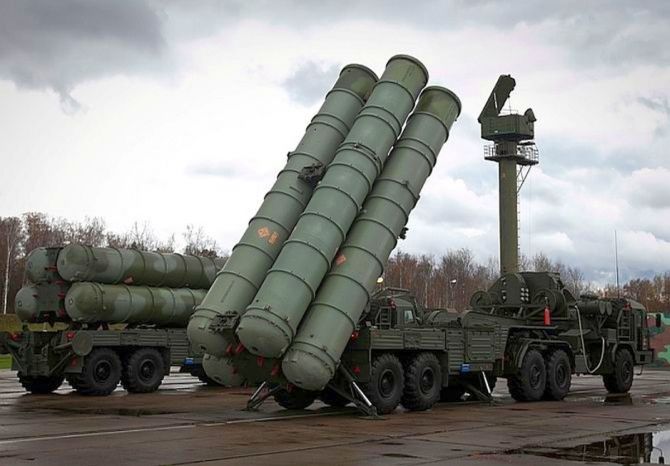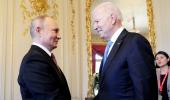New Delhi is vulnerable to US sanctions under a 2017 law called CAATSA.

With Russia facing increasing waves of economic and financial sanctions imposed by Western democracies, countries such as India, which are dependent on Moscow for a large percentage of their defence equipment, are facing hard choices.
White House Press Secretary Jen Psaki, describing President Joe Biden's meeting with G7 leaders on February 24, had promised 'devastating packages of sanctions' on Russia.
Amongst the measures announced by the White House are 'Sweeping restrictions on Russia's military to strike a blow to Putin's military and strategic ambitions.'
'Exports of nearly all US items and items produced in foreign countries using certain US-origin software, technology or equipment will be restricted to targeted military end-users. These comprehensive restrictions apply to the Russian Ministry of Defence, including the Armed Forces of Russia, wherever located,' stated the White House on February 25.
'This includes Russia-wide denial of exports of sensitive technology, primarily targeting the Russian defence, aviation and maritime sectors to cut off Russia's access to cutting-edge technology,' the White House added.
Defence business between Russia and India is booming, with contracts worth over $15 billion in the pipeline. In 2019, the authoritative Stockholm International Peace Research Organisation report put Russia as India's biggest arms supplier from 2014-2018, accounting for 58 per cent of all India's defence exports.
The Indian Air Force is the world's biggest buyer of Russian air defence equipment, much of it controversial, such as the $5.43 billion contract for five S-400 Triumf air defence units. Washington has objected strenuously to this purchase, and New Delhi is vulnerable to US sanctions under a 2017 law called 'Countering America's Adversaries Through Sanctions Act' (CAATSA).
This mandates sanctions against countries that engage in 'significant transactions' with Russian, Iranian and North Korean defence and intelligence entities. The US Congress has empowered American presidents to waive these sanctions, but Washington sources say waivers would be given only in exceptional cases.
Given the outrage in Western capital cities over Russia's invasion of Ukraine, any waiver to India over the S-400 appears highly unlikely. US President Joe Biden, asked by a reporter on February 24, whether India -- a 'Major Defence Partner' of the US -- was in sync with Washington on Russia, responded less than fulsomely: 'We were in consultation with India today. We haven't resolved that completely.'
An even more complicated issue between India, Russia and Ukraine relates to a $3 billion contract between the three countries for the purchase of four Russian Krivak-III frigates by India. Of these, two are to be supplied fully built by Russia, while the other two frigates are to be built in Goa Shipyard.
However, these frigates are powered by Ukrainian Zorya gas turbines, which Kyiv has refused to supply Moscow after 2014, when Russia annexed the Ukrainian region of Crimea.
With some difficulty, New Delhi negotiated an arrangement that requires India to buy the Zorya turbines from Ukraine and transport them to Yantar Shipyard, Russia, where they would be installed on the two Krivak-III frigates and then sailed to India.
While this arrangement catered for all sensibilities, Ukraine is now highly unlikely to supply the Zorya turbines to Russia. India will have to find a way to make these warships operational.
India is also dependent upon Ukraine for the ongoing upgrade of its 100-plus Antonov-32 medium lift transport aircraft. While the aircraft's primary manufacturer, Antonov, is located in the Ukraine, different parts of the aircraft come from various places in the former Soviet Union.
With Moscow blocking those supplies, Antonov is having to manufacture its own components and systems needed for upgrading the AN-32.
Meanwhile, Ukraine's sophisticated arms industry has also supplied about 320 high-quality T-80UD tanks to the Pakistan army.
However, the strategic nature of weapons purchases between India and Russia creates its own compulsions. In 2019, New Delhi signed a $3 billion contract with Moscow, leasing a Russian nuclear attack submarine (SSN) for ten years, starting 2025. Moscow understands and exercises the influence this generates.
Among other defence sales under way between India and Russia, Prime Minister Narendra Modi inaugurated a factory in 2019 that will manufacture at least 750,000 AK-203 Kalashnikov rifles for the Indian Army, worth another billion dollars.
Meanwhile the IAF wants to buy and upgrade 21 MiG-29 fighters lying unused in Russia for about a billion dollars. The IAF has also mooted a new contract to build 18 Sukhoi-30MKI fighters in Hindustan Aeronautics Ltd for over $800 million.
And HAL and Russian Helicopters have tied up to build 200 Kamov 226T light helicopters in India, worth about $2 billion. Also in the pipeline is a contract for 'very short range air defence systems', where a Russian vendor has bid lowest.









